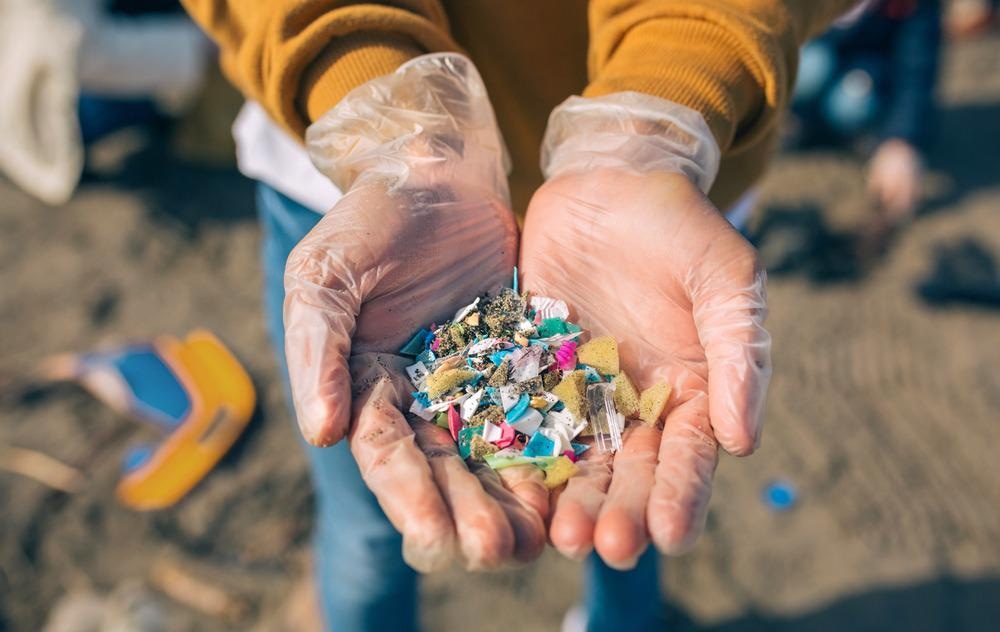Apr 29 2021
Recently at the Annual Conference of the Microbiology Society, Yang Liu, a scientist at Hong Kong Polytechnic University, presented a new method to capture and recover microplastics.

Image Credit: David Pereiras/Shutterstock.com
The technique involves using bacterial biofilms, a sticky material produced by micro-organisms, to capture microplastic particles. The biofilm is subsequently treated and dispersed, discharging the microplastics for processing and recycling.
To trap microplastics in a bioreactor, Liu and associates used the bacterium Pseudomonas aeruginosa. This bacteria species is easily available in all environments and has formerly been proven to colonize microplastics in the surroundings.
The P. aeruginosa biofilms cause the microplastics to amass together, which ultimately causes them to sink. Liu noted that in bioreactors, the microplastics can be more conveniently collected. Once the microplastics were trapped by the biofilms and had sunk to the reactor’s bottom, the team used a biofilm-dispersal gene to make the biofilm discharge the microplastics.
Liu described that this “allows convenient release of microplastics from the biofilm matrix, which is otherwise difficult and expensive to degrade, so that the microplastics can be later recovered for recycling.”
Microplastics are extremely problematic and pose a huge risk to food chains and human health, said Liu.
They are not easily bio-degradable, where they retain in the ecosystems for prolonged durations. This results in the uptake of microplastics by organisms, leading to transfer and retention of microplastics down the food chain. Due to their huge surface area and adsorption capacity, microplastics can adsorb toxic pollutants, such as pesticides, heavy metals, and drug residues at high concentrations.
Yang Liu, Researcher, Hong Kong Polytechnic University
“This leads to biological and chemical toxicity to organisms in the ecosystems and humans after prolonged unintended consumption of such microplastics. Moreover, microplastics are also difficult to remove in wastewater plants, resulting in their undesired release into the environment,” added Liu.
The following steps of the study involve advancing the proof-of-principle from the lab to an environmental setting.
We next plan to isolate and identify natural pro-biofilm forming bacterial isolates either from the sewage or from aquatic environments, where they display heightened abilities to colonise and form biofilms on microplastics.
Yang Liu, Researcher, Hong Kong Polytechnic University
Liu and his team anticipate the method will ultimately be used in wastewater treatment plants to block the escape of microplastics into the oceans. They must also identify natural compounds to trigger biofilm dispersal of the pro-biofilm creating bacterial isolates, stating that “this provides a basis for future applications in wastewater treatment plants, where microplastics can be removed in a safe and environmentally friendly manner.”
Microplastics are a colossal problem, and more methods are necessary to safely eliminate them from the environment, Liu explains the significance of this, saying “it is imperative to develop effective solutions that trap, collect, and even recycle these microplastics to stop the ‘plastification’ of our natural environments.”
Biofilms are created when communities of bacteria amass together and form a shield, or biofilm, from sticky exopolymeric materials. Biofilms can be challenging as they safeguard the bacteria from external influences such as antibiotics and environmental changes.
Microplastics are, in general, plastic particles measuring less than 5 mm in diameter. They can penetrate the environment via various sources, such as the washing of synthetic clothing, breakdown of car tires, degradation of larger plastic pieces, and plastic waste straight from industries. The existing approaches for microplastic disposal, for example, storage in landfills or incineration, are inadequate and have their own drawbacks.